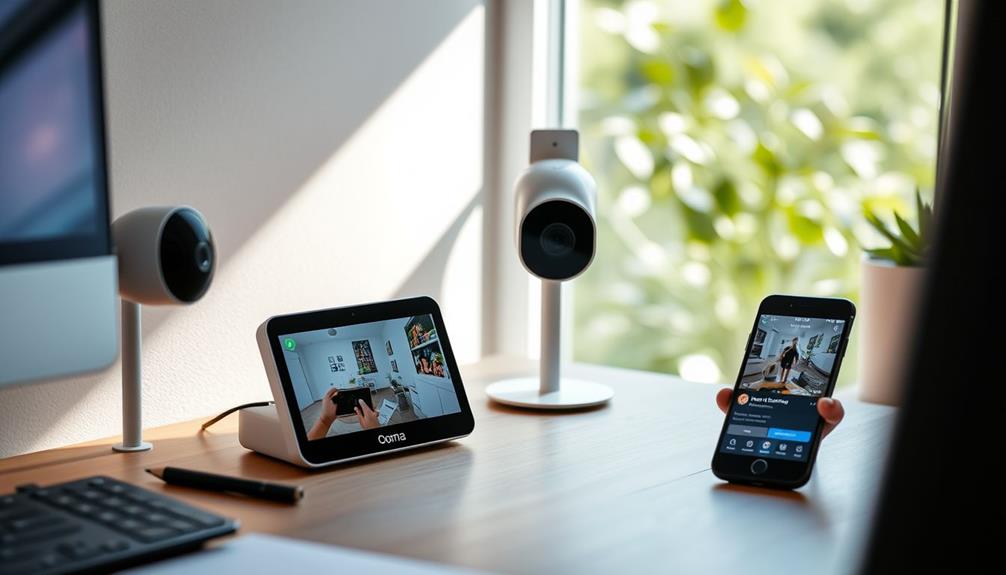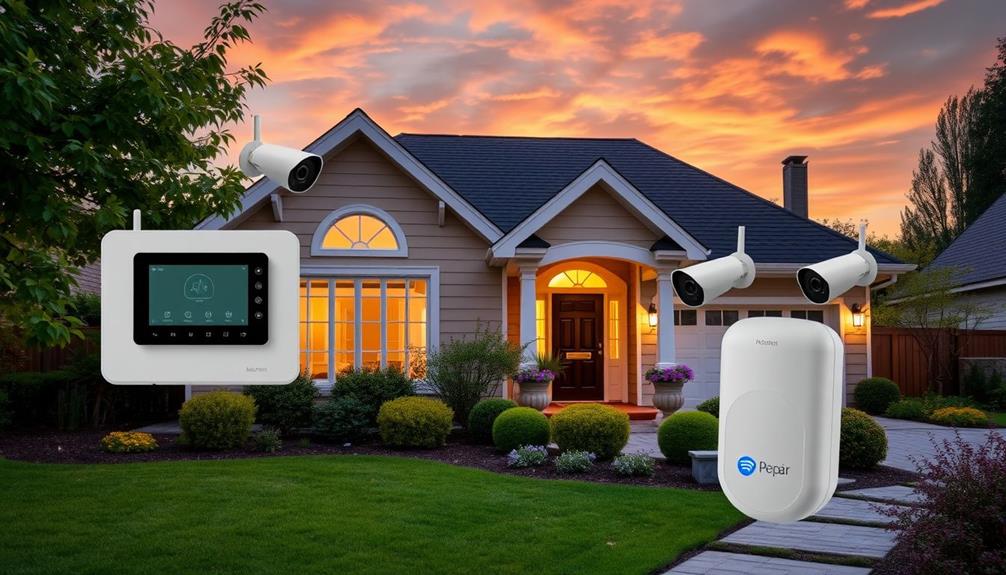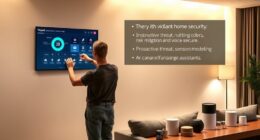Self-monitoring your home security system is simple. First, choose systems like SimpliSafe or Abode that allow customization and have user-friendly apps. Position cameras and sensors strategically to cover entry points and blind spots, ensuring everything's connected to your Wi-Fi. Download the mobile app for real-time monitoring, where you can access live feeds and receive instant alerts. Regularly test your system, replace batteries, and update software to keep everything running smoothly. If you want to explore more tips and ideas for enhancing your home security experience, you're in the right place!
Key Takeaways
- Choose a customizable home security system like SimpliSafe or Abode for budget-friendly, user-friendly features and real-time alerts.
- Install high-quality cameras and sensors strategically at vulnerable entry points, following manufacturer guidelines to avoid security gaps.
- Utilize mobile apps for remote access, allowing you to monitor live feeds, control the system, and receive real-time alerts on your smartphone.
- Perform regular maintenance by testing sensors, cleaning equipment, and updating software to ensure optimal functionality and security.
Choosing the Right System
When choosing the right self-monitoring security system, consider options like SimpliSafe and Abode for their customizable setups that fit your budget without long-term contracts.
These self-monitored security systems allow you to tailor your equipment to your specific needs, guaranteeing you only pay for what you want.
To enhance your decision-making process, think about how a design thinking approach can help you assess your requirements and prioritize features effectively.
Look for systems that offer essential features such as real-time alerts and user-friendly mobile apps, which enhance your ability to monitor your home effectively from anywhere.
Evaluate the equipment quality to assure reliability and performance.
It's also vital to check compatibility with smart home devices, as this integration can boost your system's functionality.
Opt for systems that allow for easy DIY installation, saving you money on professional services and providing the flexibility to upgrade or relocate your system later on.
Lastly, consider the long-term viability of your chosen system.
Look for warranty options and customer support availability to guarantee you have reliable assistance whenever needed.
Installation Steps for Success

To guarantee a successful installation of your self-monitoring security system, start by choosing the right equipment that suits your needs.
Consider checking for customer reviews to gain insights into the reliability and effectiveness of the products you're considering.
Follow a step-by-step setup guide to make the process straightforward and efficient.
With the right preparation, you'll have your system up and running in no time.
Choosing Equipment Wisely
Choosing the right equipment is crucial for creating an effective self-monitoring home security system that meets your specific needs. Start by evaluating your home's layout to identify vulnerable entry points. This will help you strategically place security cameras, motion detectors, and sensors for maximum coverage. Additionally, consider factors such as the size of your property and the range of the devices to ensure comprehensive surveillance. If you’re wondering **which Ring doorbell to buy**, take into account features like video quality, night vision, and two-way audio, as these can significantly enhance your security setup. By carefully selecting compatible devices, you’ll create a cohesive system that keeps your home protected and gives you peace of mind. It’s also important to integrate your home security devices into a central hub or app for easy monitoring and control, allowing you to manage everything from one platform. Regularly maintaining your system is key, including clearing unnecessary data to free up storage space; for example, you can periodically **delete all Ring doorbell events** to ensure optimal performance. By staying proactive and responsive to your system’s needs, you’ll maintain a robust security setup that adapts as your requirements evolve.
Consider how innovative design and functionality can enhance your security setup, guaranteeing that each device not only serves a purpose but also blends seamlessly into your home environment. Look for high-quality cameras equipped with features like night vision and motion detection, as these enhancements greatly improve monitoring during low-light conditions and provide timely alerts.
When selecting your equipment, consider the following:
- Compatibility: Verify your devices can integrate seamlessly with existing smart home platforms like Amazon Alexa or Google Home.
- Quality: Opt for high-end cameras and sensors that guarantee reliability and performance.
Once installed, test all equipment to confirm notifications work correctly. You'll want to verify you can access live footage and alerts through your smartphone app for efficient self-monitoring.
Step-by-Step Setup Guide
Now that you've selected the right equipment, it's time to set up your self-monitoring home security system with a straightforward step-by-step guide. First, ensure all devices are charged or connected to their power sources, and follow the manufacturer’s guide to connect them to your home Wi-Fi network. Once everything is set up, you can manage and customize your system via the smartphone app provided. If you encounter any issues or need assistance, it’s helpful to refer to the manual for instructions on how to reset home security settings and reconfigure your devices if necessary.
First, unpack your system and read the manufacturer's instructions carefully for a smooth DIY installation. Position cameras, sensors, and alarms strategically to cover all entry points and any potential blind spots. Incorporating a balanced lifestyle, similar to managing heart health, can enhance your overall sense of safety and well-being in your home, as holistic lifestyle choices can provide peace of mind.
Next, connect your security system to your home Wi-Fi network. This step is essential for receiving real-time alerts and accessing video feeds. Download the corresponding smartphone app to manage your system from anywhere. Once everything's connected, test each component. Trigger the alarms and motion sensors to verify notifications come through promptly.
Lastly, don't forget about software updates. Regularly check for updates on your security system and smartphone app to maintain security features. This will also help integrate with any additional smart home devices you may have.
Utilizing Mobile Apps

With mobile apps for your self-monitoring home security system, you can easily access essential features right from your smartphone.
These apps often provide additional functionalities, such as essential oils for relaxation that can help create a calming environment at home.
You'll receive real-time notifications about security events and have the ability to control your system remotely.
This level of convenience not only enhances your safety but also keeps you connected to your home, no matter where you are.
Mobile App Features
Mobile apps for self-monitored home security systems empower you to stay connected and in control, providing real-time alerts and remote access to your home's security features. Many modern systems now come equipped with advanced features such as top-rated garage door openers, enhancing overall security.
With these apps, you can easily monitor your home from anywhere, ensuring peace of mind whether you're at work or on vacation.
Key features of mobile apps include:
- Live video feeds: Access live video feeds from security cameras, allowing you to visually check on your property anytime.
- Remote arm and disarm: Control your security system remotely, giving you the flexibility to arm or disarm your system even when you're away.
Additionally, you can review activity logs to keep tabs on who's entering or leaving your home. Some systems even allow you to share access to the app with trusted friends or family members, enhancing collective monitoring.
With these features, mobile apps enhance your ability to protect your home and respond to potential security threats effectively.
Real-Time Notifications
Real-time notifications keep you informed about security events as they happen, guaranteeing you can respond promptly to any potential threats.
With mobile apps from self-monitoring systems like Canary, you receive instant push notifications for alarm triggers, allowing you to stay alert without being physically present.
In today's digital age, understanding credit card terms is crucial for financial literacy, especially when considering the financial implications of home security systems. You can customize these settings to focus on specific events, such as motion detection or door/window openings, enhancing your personalized security management.
When you receive security alerts, you can quickly assess the situation using live video feeds available through the app. This immediate access to recorded footage not only verifies the alert but also helps you make informed decisions about your response.
The ease of installation and functionality of systems like the Canary system guarantees you won't miss critical updates, no matter where you are.
Moreover, some systems integrate seamlessly with smart home devices, offering you even more control.
Whether you're at work or on vacation, real-time notifications empower you to maintain security and peace of mind, making self-monitoring not only effective but also convenient.
Remote Access Control
Having instant alerts at your fingertips is just the beginning; remote access control through dedicated apps lets you manage your home security from anywhere.
With mobile apps designed for self-monitoring systems, you can receive real-time alerts and notifications right on your smartphone. These apps allow you to access live video feeds, arming and disarming your system with just a tap.
Here are some key benefits of using remote access control:
- Customization of alert preferences: Set specific notifications for different events, like motion detection or door breaches, so you only get the alerts that matter to you.
- Cloud storage for video footage: Easily review recorded events remotely, ensuring you have access to essential evidence whenever needed.
Regular Maintenance Tips

To keep your self-monitoring home security system running smoothly, it's essential to perform regular maintenance checks and updates.
Start by testing all sensors and alarms at least once a month. This helps guarantee they're functioning properly and alerts you to any issues before they escalate.
Every few weeks, clean your cameras and lenses with a soft cloth to maintain clear visibility for peak performance in your security footage.
Don't forget to replace batteries in your wireless sensors and cameras every 6-12 months. Low power can lead to system failures, so staying proactive is key.
Additionally, review and update your security system's software and firmware quarterly to protect against vulnerabilities and access new features.
Lastly, conduct a thorough inspection of the entire system at least twice a year. Check connections and placements to confirm all components are secure and provide maximum coverage.
Enhancing Security With Sharing

Sharing access to your self-monitored home security system can greatly boost your overall security by allowing trusted family members or friends to stay informed and take action when needed. By utilizing shared access, you enhance security through collective vigilance and responsiveness.
- Faster response to alerts: With multiple users monitoring live feeds, you can quickly evaluate situations and decide on the best course of action.
- Effective management of false alarms: Shared users can independently verify alerts, reducing the chances of unnecessary calls to authorities.
Many self-monitoring options, like SimpliSafe and Abode, offer user-friendly mobile apps that facilitate this shared access.
By inviting trusted individuals into your security network, you're not just relying on one person to keep watch; you're creating a community of vigilance.
This shared approach not only enhances your overall security but also fosters a sense of responsibility among all users.
Troubleshooting Common Issues

Common issues with self-monitoring home security systems can often be resolved by following a few straightforward troubleshooting steps.
First, guarantee all your home security devices are properly connected to your network. Poor Wi-Fi connectivity can lead to missed notifications and real-time alerts from your alarm system.
Next, check the battery levels of your motion sensors and security cameras regularly. Low batteries can cause these devices to malfunction or stop sending alerts altogether.
It's also vital to review your app settings to confirm that notifications are enabled and that your device is set to receive alerts in real-time.
If your motion sensors aren't triggering as expected, recalibrate their sensitivity settings. Environmental factors or obstructions might interfere with their detection capabilities.
To guarantee everything is functioning correctly, don't forget to test your alarm system regularly. Simulate an alarm event to verify that all components, including sirens and notifications, respond appropriately during an actual emergency.
Frequently Asked Questions
Can I Self Monitor My Home Security System?
Yes, you can absolutely self-monitor your home security system. Many modern systems allow you to receive alerts and control settings via your smartphone, giving you full control without extra monthly fees. Just stay responsive!
Can I Self Monitor My ADT Alarm System?
Yes, you can self-monitor your ADT alarm system if you choose compatible equipment or select a self-monitoring plan. You'll receive alerts on your smartphone, allowing you to respond quickly without monthly fees.
How Can I Monitor My Home Security Camera Remotely?
Imagine peering through a digital window. You can monitor your home security camera remotely by connecting it to Wi-Fi, using the manufacturer's app for live feeds, and enabling motion alerts for instant notifications. Stay informed!
Do It Yourself Home Security System No Monitoring?
You can set up a do-it-yourself home security system without monitoring by purchasing cameras and sensors. You'll control everything through a mobile app, receiving real-time alerts while customizing the system to fit your specific needs.
Conclusion
By taking charge of your home security system, you not only protect your space but also gain peace of mind.
Did you know that homes without security systems are 300% more likely to be broken into?
Regular monitoring and maintenance are key to keeping your home safe.
With the right tools and knowledge, you can enhance your security and respond quickly to any issues.
Remember, staying proactive is the best way to safeguard what matters most.









